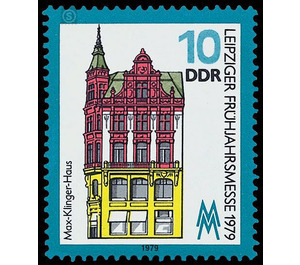Commemorative stamp series - Germany / German Democratic Republic 1979 - 10 Pfennig
Theme: Architecture
| Country | Germany / German Democratic Republic |
| Issue Date | 1979 |
| Face Value | 10.00 |
| Color | multi-colored |
| Perforation | K 14 |
| Printing Type | offset |
| Stamp Type | Postage stamp |
| Item Type | Stamp |
| Chronological Issue Number | 2145 |
| Chronological Chapter | GER-DDR |
| SID | 683150 |
| In 31 Wishlists | |
Leipziger Spring Fair 1979 At the Leipzig Spring Fair 1979, the Ministry of Posts and Telecommunications of the German Democratic Republic issued two multi-colored special postage stamps. Special cancellation from March 6 to May 5, 1979 10 Pfennig value: Max Klinger House "Kligners Haus" stands, carved in marble, above the entrance gate of the building on the corner of Schloßgasse / Petersstraße in the center of Leipzig. It can be found on the site where from 1722 to 1859 the Peterstor, the most beautiful of the four Leipzig city gates was built by the master of baroque Daniel Pöppelmann. In the past, the old trade route "Via Imperii" coming from the south soon reached Leipzig. The building was created on behalf of the father of the famous Leipzig artist Max Klinger according to his designs as a residential and commercial building in the years 1887/88. The architect was the architect Arwed Roßbach, who became known through numerous splendid representative buildings. Previously, the birthplace of Max Klinger (1857-1920), who as a genius of its own versatility, as a painter, sculptor and graphic artist is one of the historically significant Leipzig artist personalities. His major works, including the large sculpture "Beethoven", are exhibited in the Museum of Fine Arts in Leipzig. The house is an urban dominant feature at the exit of the Petersstraße and stands in particular by its on the upper floors richly ornamented relief-plastic design in the point of view. Particularly striking is the successful use of cataloged ceramic elements, which offered the industry of the end of the 19th century. The architecture is preserved in the forms of the Neo-Renaissance on two modern basement floors, where business premises are located. In the years 1975/76 the complete reconstruction of the facade took place. Above all, the formally established shop zone was restored to the original architectural point of view and thus the artistic context with the upper storeys became more visible again.


